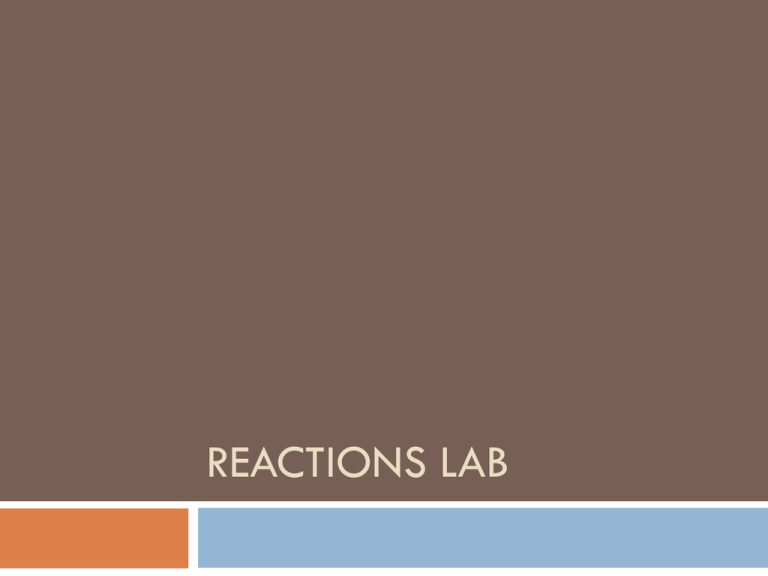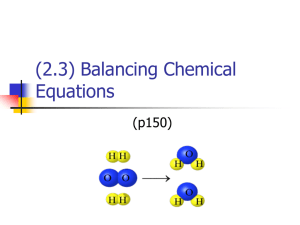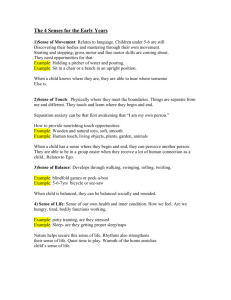Reactions Lab
advertisement

REACTIONS LAB Section I Combination Reactions Combination reactions occur when two or more substances come together to form a single, new substance. A + B AB Reaction 1 Steel wool (iron with a +3 charge) combines with oxygen. Observations: Turned blue Reduced mass to a gas Complete balanced equation: 4Fe(s) + 3O2(g) 2Fe2O3(s) Reaction 2 Copper wool (copper with a +1 charge) combines with oxygen. Observations: Flame turned green Copper color changed to black Complete balanced equation: 4Cu(s) + O2(g) 2Cu2O(s) Reaction 3 Magnesium combines with oxygen. Observations: Bright white light Turned into a white powder Complete balanced equation: 2Mg(s) + O2(g) 2MgO(s) Reaction 4 Combination of calcium oxide and water. What color were the contents of the test tube after the indicator was added? Blue Does this color indicate an acid or a base? Base Complete balanced equation: CaO(s) + H2O(l) Ca(OH)2(aq) can also be written as… CaO(s) + HOH(l) Ca(OH)2(aq) Reaction 5 Combination of carbon dioxide and water. Observations: Bubbles being blown in water Color changed from blue to green to yellow What acidic product can you predict for this combination reaction? H2CO3 = carbonic acid Complete balanced equation: CO2(g) + H2O(l) H2CO3(aq) Section II Decomposition Decomposition reactions result as one substance breaks down to two or more simpler substances. AB A + B Reaction 6 Hydrogen peroxide decomposition. Observations: Bubbles let off Splint was re-ignited Write a complete balanced equation MnO2 2H2O2(aq) O2(g) + 2H2O(g) Reaction 7 Sodium hydrogen carbonate decomposition. Observations: Gas being let out Condensation at mouth of test tube Complete balanced equation: 2NaHCO3(s) H2O(g) + CO2(g) + Na2CO3(s) Section III Single Replacement Reactions In this reaction, one substance will replace another substance in the compound. A + BC AC + B Reaction 8 Reaction of calcium and water. Does the color indicate the presence of an acid or a base? What is the product? Observations: N/A Complete balanced equation: Ca(s) + 2H2O(l) Ca(OH)2(aq) + H2(g) Reaction 9 Reaction of zinc and hydrochloric acid Observations: Bubbles/gas Zinc dissolving Complete balanced equation: Zn(s) + 2HCl(aq) ZnCl2(aq) + H2(g) Reaction 10 Reaction of zinc and lead (II) nitrate. Record your observations: Bubbles/gas Color change (bright silver to dark silver) Complete balanced equation: Zn(s) + Pb(NO3)2(aq) Zn(NO3)2(aq) + Pb(s) Section IV Double Replacement Reactions In double replacement reactions, the substances are dissolved in water and ionic in nature. This means that when you mix the two substances, the ions are free to move around and find another partner. If the partnership results in a compound which is insoluble in water, a precipitate (solid) will form. If a gas is formed, you will see bubbles. AB + CD AD + CB Reaction 11 Sodium carbonate reacts with barium nitrate. Observations: N/A Complete balanced equation: Na2CO3(aq) + Ba(NO3)2(aq) 2NaNO3(aq) + BaCO3(s) Reaction 12 Lead (II) nitrate reacts with potassium iodide. Observations: A solid is formed The color changes to yellow Complete balanced equation: Pb(NO3)2(aq) + 2KI(aq) PbI2(s) + 2KNO3(aq) Reaction 13 Sodium hydrogen carbonate reacts with hydrochloric acid. Observations: Foaming Bubbles Complete balanced equation: NaHCO3(s) + HCl(aq) NaCl(aq) + H2CO3(aq) Note the “acid” product in this reaction is unstable and breaks down to form carbon dioxide and water. H2CO3(aq) H2O(l) + CO2(g) Reaction 14 Calcium carbonate reacts with hydrochloric acid. Observations: N/A Write a complete balanced equation for this reaction. CaCO3(s) + 2HCl(aq) CaCl2(aq) + H2CO3(aq) Note the “acid” product in this reaction is unstable and breaks down to form carbon dioxide and water. H2CO3(aq) H2O(l) + CO2(g) Section V Combustion of Hydrocarbon When a compound composed of carbon and hydrogen burns in the presence of oxygen, carbon dioxide and water are produced. Hydrocarbon + O2 CO2 + H2O Reaction 15 The combustion of methane. Description of the flame: Blue Inner cone and outer cone Complete balanced equation: CH4(g) + 2O2(g) CO2(g) + 2H2O(g) Reaction 16 The combustion of ethanol. Observations: N/A Write a complete balanced equation for this reaction. C2H5OH(l) + 3O2(g) 2CO2(g) + 3H2O(g)





